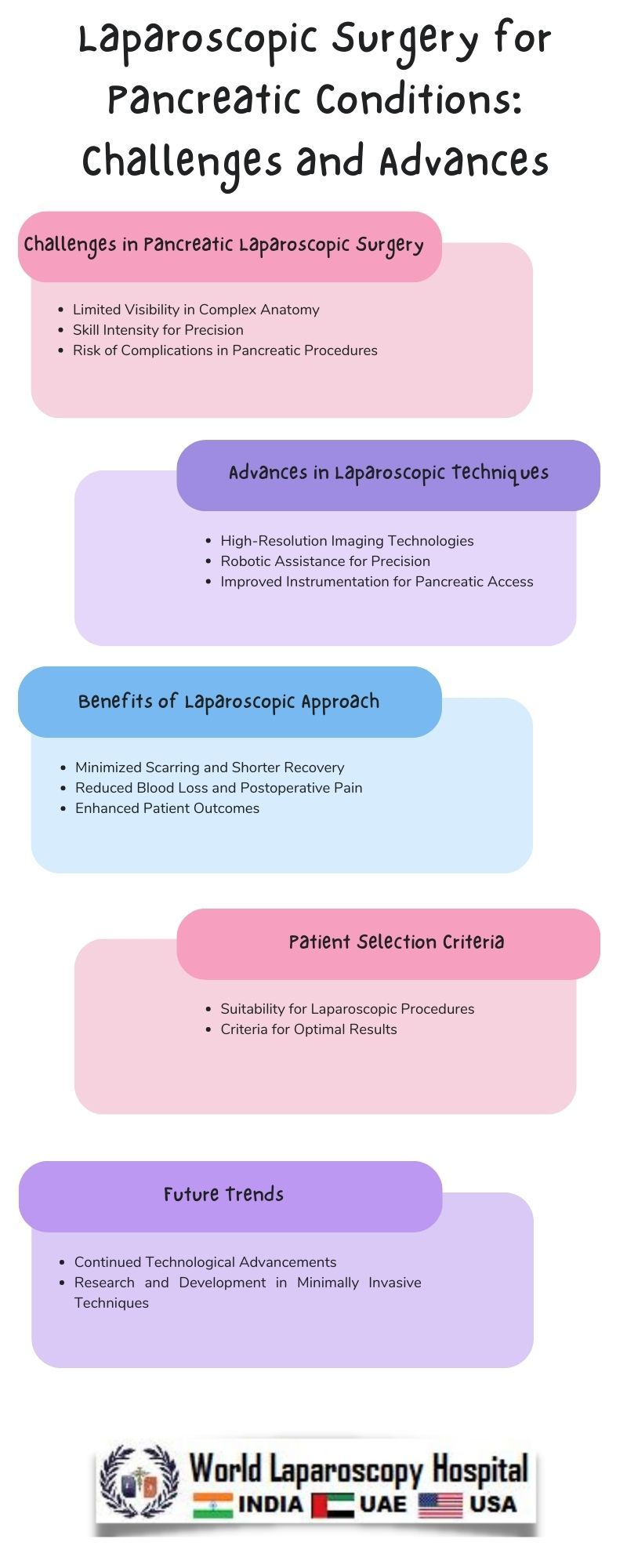Laparoscopic Surgery for Pancreatic Conditions: Challenges and Advances
Introduction:
Pancreatic conditions, encompassing a spectrum from benign tumors to malignant cancers, pose intricate challenges for surgeons. Traditional open surgery has been the standard approach for pancreatic interventions. However, the landscape is evolving with the advent of laparoscopic surgery, offering a less invasive alternative. In this article, we delve into the challenges associated with laparoscopic pancreatic surgery and explore the recent advances that have transformed its landscape.

Understanding Pancreatic Conditions:
The pancreas, a vital organ involved in digestion and blood sugar regulation, is susceptible to various conditions. Pancreatitis, cysts, and tumors, both benign and malignant, necessitate surgical intervention for treatment. Traditionally, open surgery involves a large incision to access the pancreas, but it comes with significant morbidity and a prolonged recovery period.
Evolution of Laparoscopic Surgery:
Laparoscopic surgery, also known as minimally invasive surgery, has gained traction across various specialties. It involves making small incisions through which a camera and specialized instruments are inserted, allowing surgeons to perform complex procedures with reduced trauma. The application of laparoscopy to pancreatic surgery, however, comes with its own set of challenges.
Challenges in Laparoscopic Pancreatic Surgery:
Anatomical Complexity:
The pancreas's intricate location behind the stomach and adjacent to vital structures makes accessing it laparoscopically challenging. Surgeons must navigate around organs and blood vessels with precision.
Limited Visualization:
Unlike open surgery, where the surgeon has a direct and unobstructed view of the operative field, laparoscopy relies on a camera feed. Limited depth perception and potential loss of tactile feedback can complicate the surgeon's ability to assess tissues accurately.
Bleeding and Hemostasis:
The pancreas is a highly vascular organ, and achieving effective hemostasis during laparoscopic procedures can be challenging. Ensuring meticulous control of bleeding is crucial to prevent complications.
Instrument Maneuverability:
The restricted movement of laparoscopic instruments can pose difficulties in achieving the precise manipulation required for complex pancreatic surgeries. Developing innovative instruments that mimic the dexterity of the human hand is an ongoing challenge.
Advances in Laparoscopic Pancreatic Surgery:
Robot-Assisted Surgery:
The integration of robotic technology has addressed some challenges in laparoscopic pancreatic surgery. Surgeons can now control robotic arms with enhanced precision and three-dimensional visualization, overcoming some of the limitations associated with traditional laparoscopy.
Fluorescence Imaging:
Fluorescence-guided surgery involves injecting a fluorescent dye that highlights specific structures, aiding in better visualization during laparoscopic procedures. This technique enhances the surgeon's ability to identify critical anatomical landmarks and assess tissue viability.
Intraoperative Ultrasound:
Real-time ultrasound imaging during surgery provides valuable information about the pancreas and surrounding structures. Surgeons can use this tool to enhance their understanding of the anatomy and improve the accuracy of resections.
Enhanced Recovery after Surgery (ERAS):
Optimizing perioperative care through ERAS protocols has revolutionized the postoperative recovery process. These multidisciplinary approaches focus on minimizing stress, maintaining organ function, and promoting early mobilization, resulting in shorter hospital stays and quicker recovery for patients undergoing laparoscopic pancreatic surgery.
Future Directions and Conclusion:
As technology continues to advance, the landscape of laparoscopic pancreatic surgery is poised for further transformation. Integration of artificial intelligence for image analysis, the development of more sophisticated robotic systems, and ongoing refinements in surgical techniques will likely contribute to overcoming current challenges.
Conclusion,
Laparoscopic surgery for pancreatic conditions represents a promising avenue in the field of surgical innovation. While challenges persist, recent advances are propelling the field forward, offering patients less invasive options with potentially quicker recovery times. The ongoing synergy between surgical expertise and technological advancements holds the key to unlocking new possibilities in the realm of pancreatic surgery.






